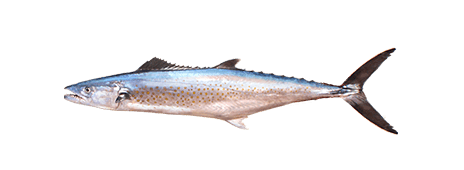Pacific Sierra

Species Details
Scomberomorus Sierra
Scombridae
Perciformes
Nearshore
12 - 18 lbs.
28" - 39"
Pacific Sierra (Scomberomorus sierra) Fish Description
Also known as the Mexican Sierra, the Pacific Sierra is a member of the mackerel (See Atlantic Mackerel, Chub Mackerel, Cero Mackerel, King Mackerel, and Spanish Mackerel) family. It is a bony, ray-finned fish under the Scomberomorini tribe or the Spanish mackerels. The genus Scomberomorus has 18 species, 5 of which are located in Mexican waters, 2 in the Pacific Ocean, and 3 in the Atlantic.
A row of gold dots embeds the area just beneath the lateral line of the Pacific Sierra’s body. The shape of its body is fusiform; it is elongated and compressed. Its color is bronze-green to bluish-black in the dorsal area and silver-white ventrally. Its sides are spotted with 3 to 8 rows of orange spots, small and round.
The anal fin of the Pacific Sierra is white while the first dorsal fin is black, and the second one, yellowish with a black margin. Pacific Sierra’s pectoral fins are dusky. Its mouth has a set of strong teeth which are sharp as a knife and triangular in shape.
Diet and Size
This species of fish is an aggressive eater. Pacific Sierras love to prey on herrings, clupeids, and anchovies.
Pacific Sierras can measure up to 39 inches and weigh 18 pounds.
Interesting Facts About the Pacific Sierra
- Pacific Sierra is a valuable fish for consumption. It tastes like jacks, but its flavor is excellent and milder.
- The best recipe with Pacific Sierra is ceviche which is a combination of raw seafood immersed in lime juice.
- Pacific Sierra is more costly than other kinds of mackerels.
- The Pacific Sierra is easily recognizable but can sometimes be confused with the Spanish Mackerel (which is generally found in the Pacific Ocean), and the Gulf Sierra which has 21 to 27 gill rakers and two rows of yellow spots.
- The word Scomberomorus is derived from the Latin scomber (meaning, ‘mackerel’), and the Greek moros (meaning, ‘stupid’)
Fishing Techniques: How to Catch a Pacific Sierra
The Pacific Sierra’s population is stable; it is a species of Least Concern. Despite its wide distribution, Pacific Sierra fishing is regulated. Recreational anglers can catch only 10 fishes per bag daily in certain parts of the US. Apart from that, Pacific Sierras cannot be caught all-year round; they are seasonal.
Artificial lures and natural baits can both be used to catch Pacific Sierras, but a wire leader is a must due to their very sharp teeth (they often bite back). Light tackle may not be enough. Anglers find landing Pacific Sierras a very fun sport.
Commercial anglers catch around 15,000 tons of Pacific Sierras every year; however, their population has decreased a little over the years. For commercial purposes, gill nets can be used.
It is best to watch out for them just below the surface using slow trolling lures (they prefer shiny lures) or baits (sardines and anchovies may be used). Pacific Sierras can also be captured via fly fishing and using flashy streamers.
Habitat and Distribution
Pacific Sierras are located in the Pacific Ocean, particularly from California to Antofagasta in Chile.
As a coastal pelagic species, Pacific Sierras school in depths measuring around 50 feet. They like water with temperatures less than 74 °F. They spawn near coastal waters; juvenile Pacific Sierras live close to the shore particularly in sandy beaches. On the other hand, adult Pacific Sierras live in deeper waters along continental shelves.







